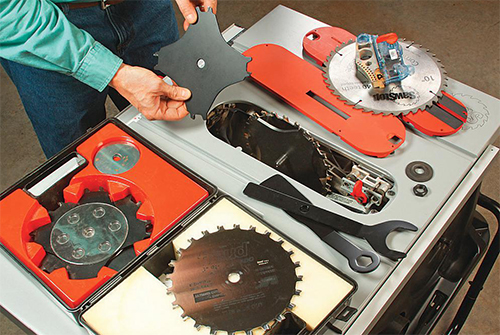
There’s been some discussion about a European ban on stacked dado blades. What are the differences between stacked and wobbly dado blades and is one safer than another?
Rob Johnstone: I can’t speak to why stacked dados are illegal in Europe (if indeed they are), but I can testify to their superiority over the wobbly rascals. Simply stated, the geometry of a wobbling cutter spinning around an arbor is not as accurate as a series of stacked blades and chippers. The stacked dados, in my opinion, are more accurate and just as safe. As with any cutting tool, safety is a result of proper use.
Early in my woodworking career, I wondered out loud why I was injuring myself so often on various woodworking tools, and why my foreman (a man of forty years woodworking experience) did not. He told me that he had decided early on, not to put his fingers into any whirling saw blades … and he had not changed his mind. In other words, take responsibility for your own safety. Since that time – after some twenty years of woodworking – I have significantly reduced my injuries from power tools. I have heard no rumors of OSHA being interested in dado blades and think it would be a classic example of overregulation if it decided to do anything about it.
Rick White: I’m not a big fan of the wobbly dado blades. They leave a crown in the bottom of the cut, and just generally don’t do as nice a job. It’s pretty clear that the stacked blade is the way to go. My only issue with a stacked dado blade is that you need to get pretty creative with your adjustments if you’ve got an odd groove to cut, like a 9/16″ wide dado. Most blades come in 1/ 8″ increments, so a 9/16″ groove takes some doing. I think Frued has a half-size chipper that can make these cuts easier to achieve.
Ian Kirby: The stacked dado blade is accurate and gives a first rate result. The wobbly dado blade is difficult to set accurately and gives a very poor result.
Whether the stacked version is legal or not in Europe is a red herring. There are many techniques and methods that are standard in Europe that are ignored in the U.S. Take, for instance, the splitter on a table saw. European machines have it rise and fall with the blade. No one ever removes it and kick backs are practically unheard of. In the U.S. the splitter does not rise and fall with the blade and is commonly removed. Consequently, kick backs are commonplace.
An unguarded blade with no splitter is a normal set up on “How To” workshops on TV. It begs the question: how to what? Have an accident?





